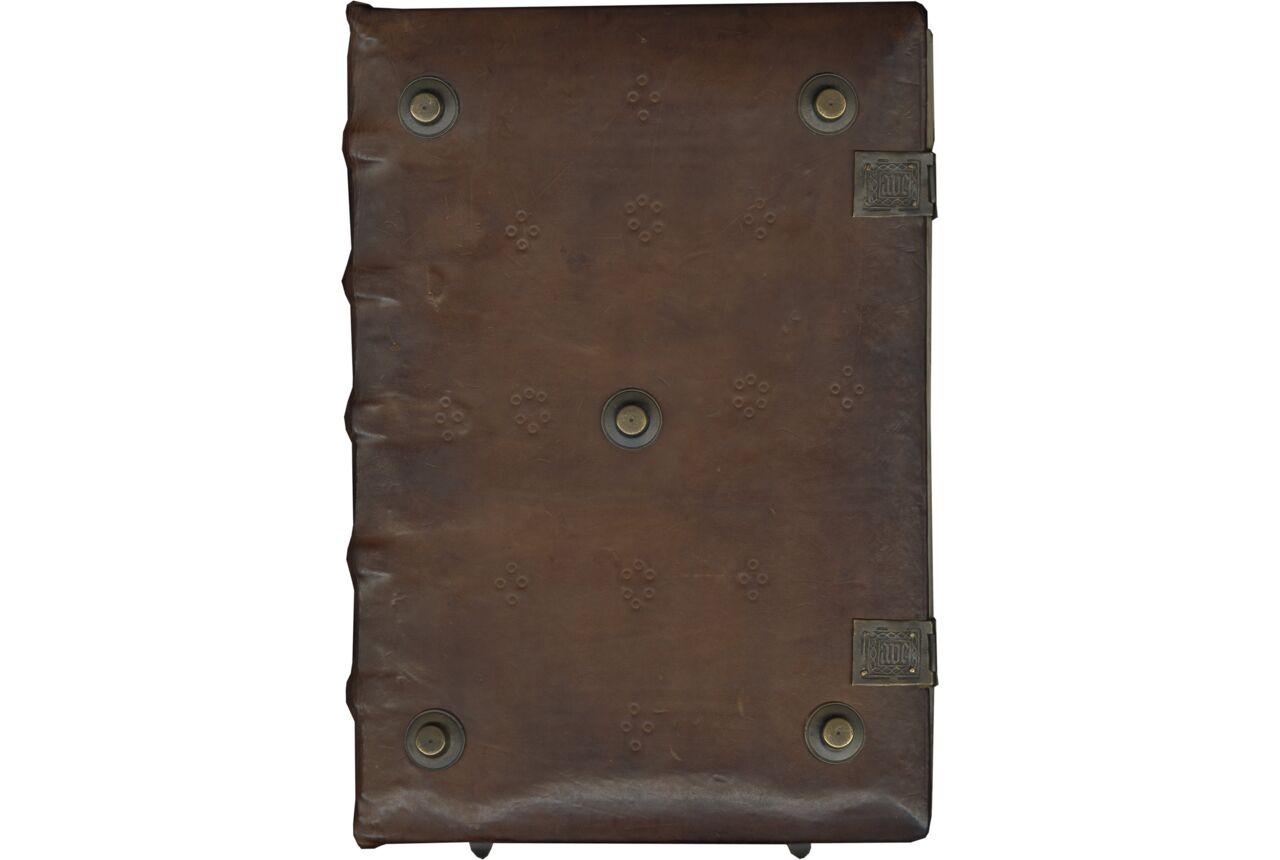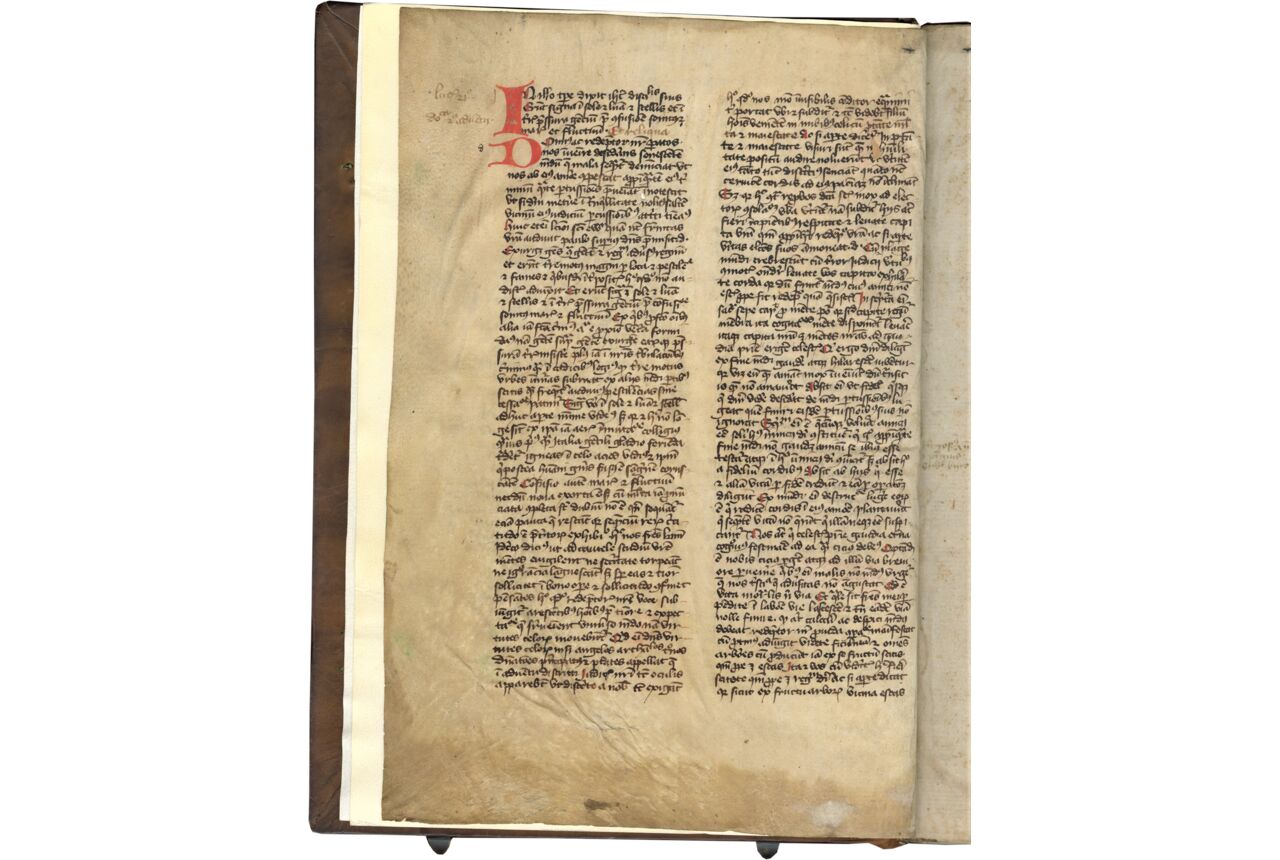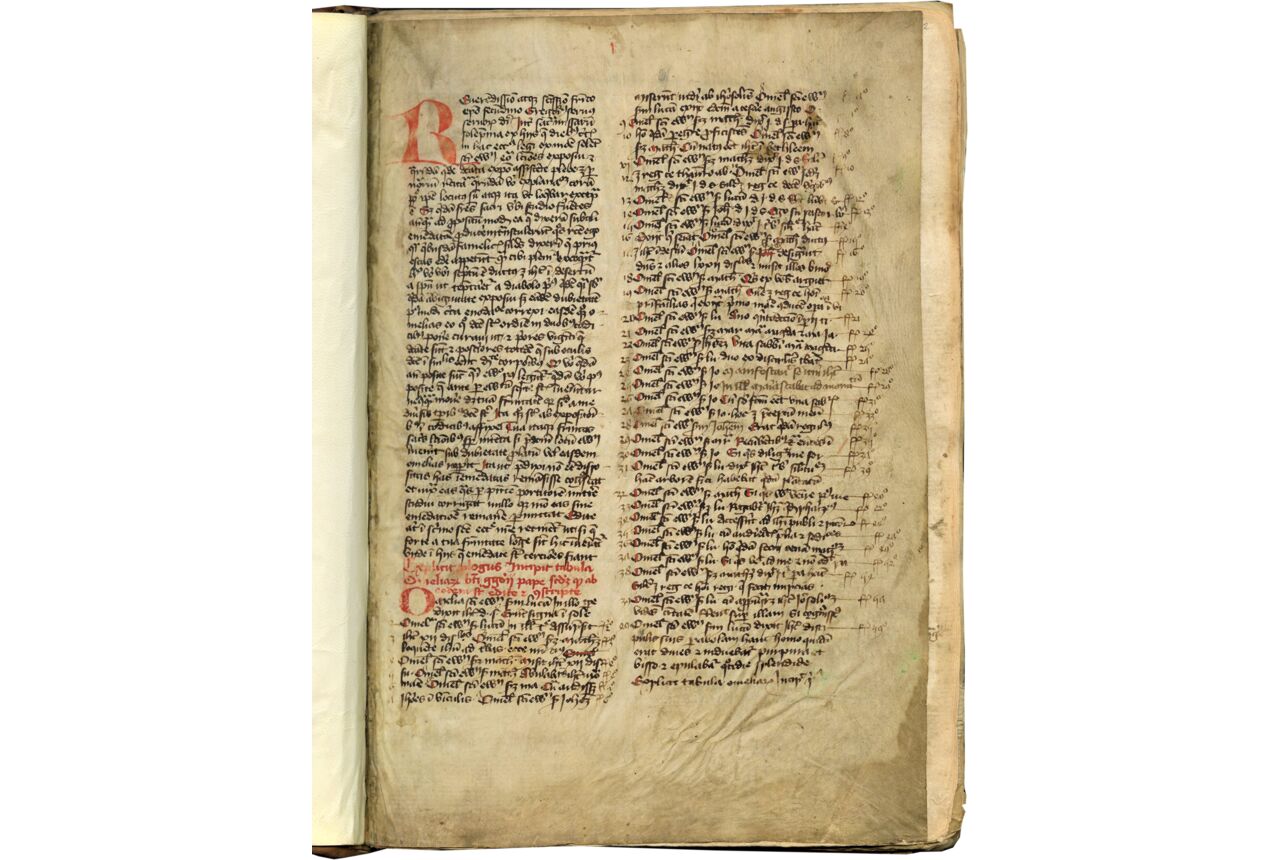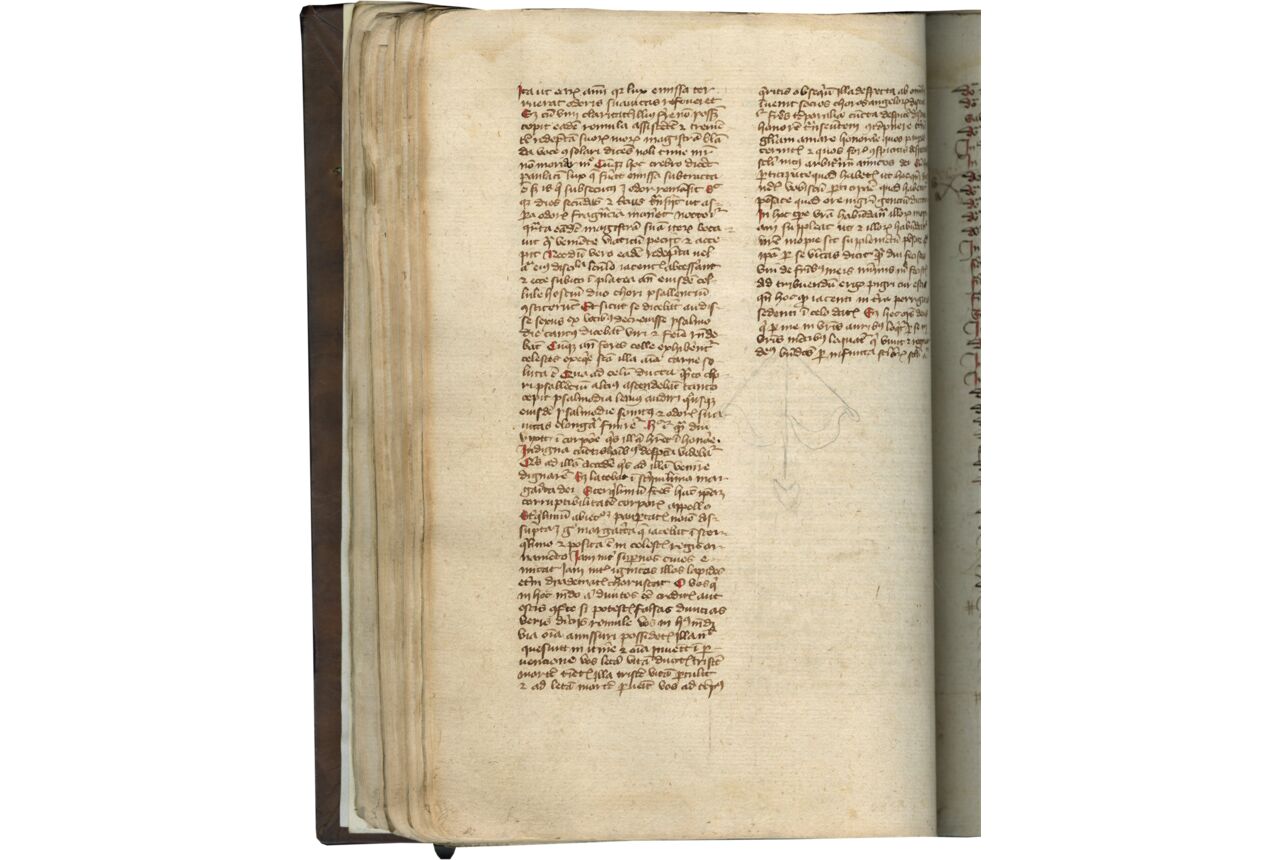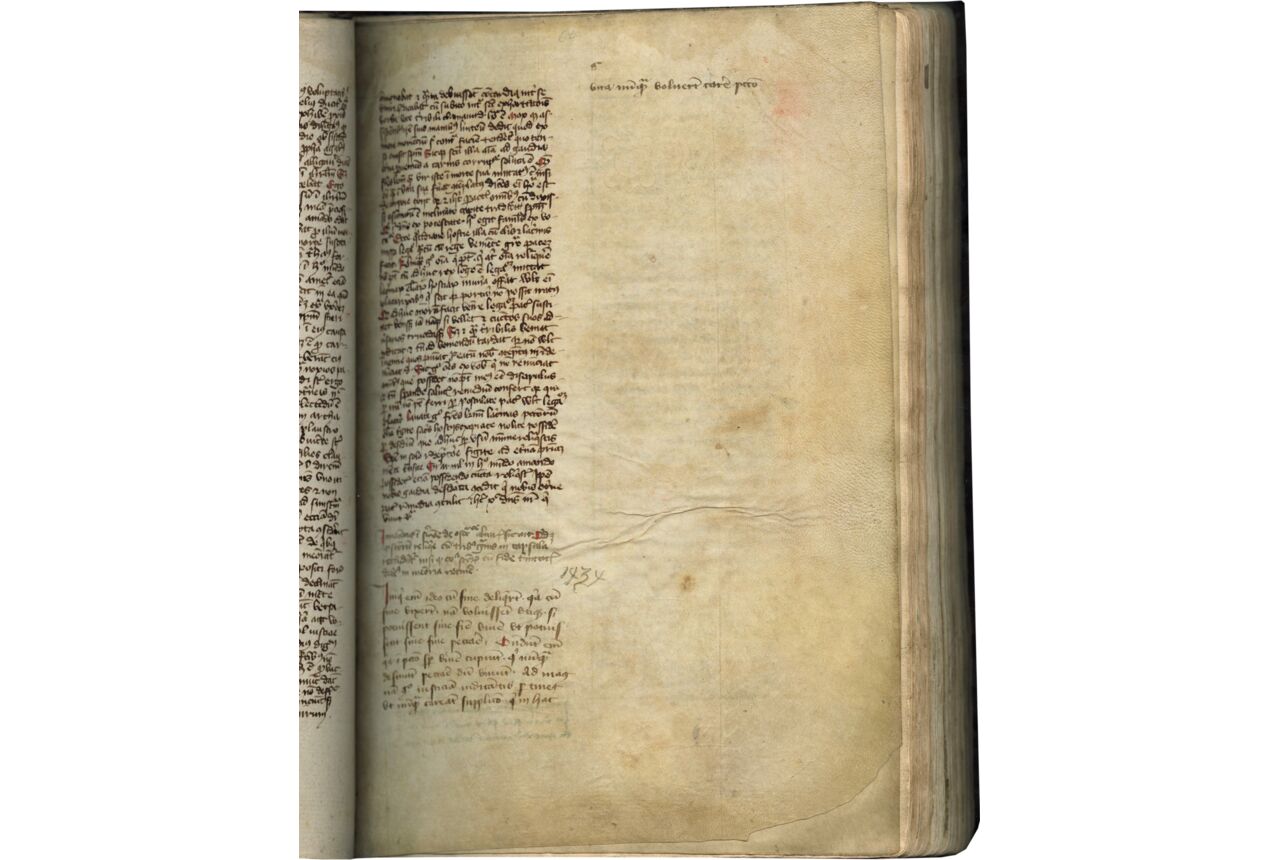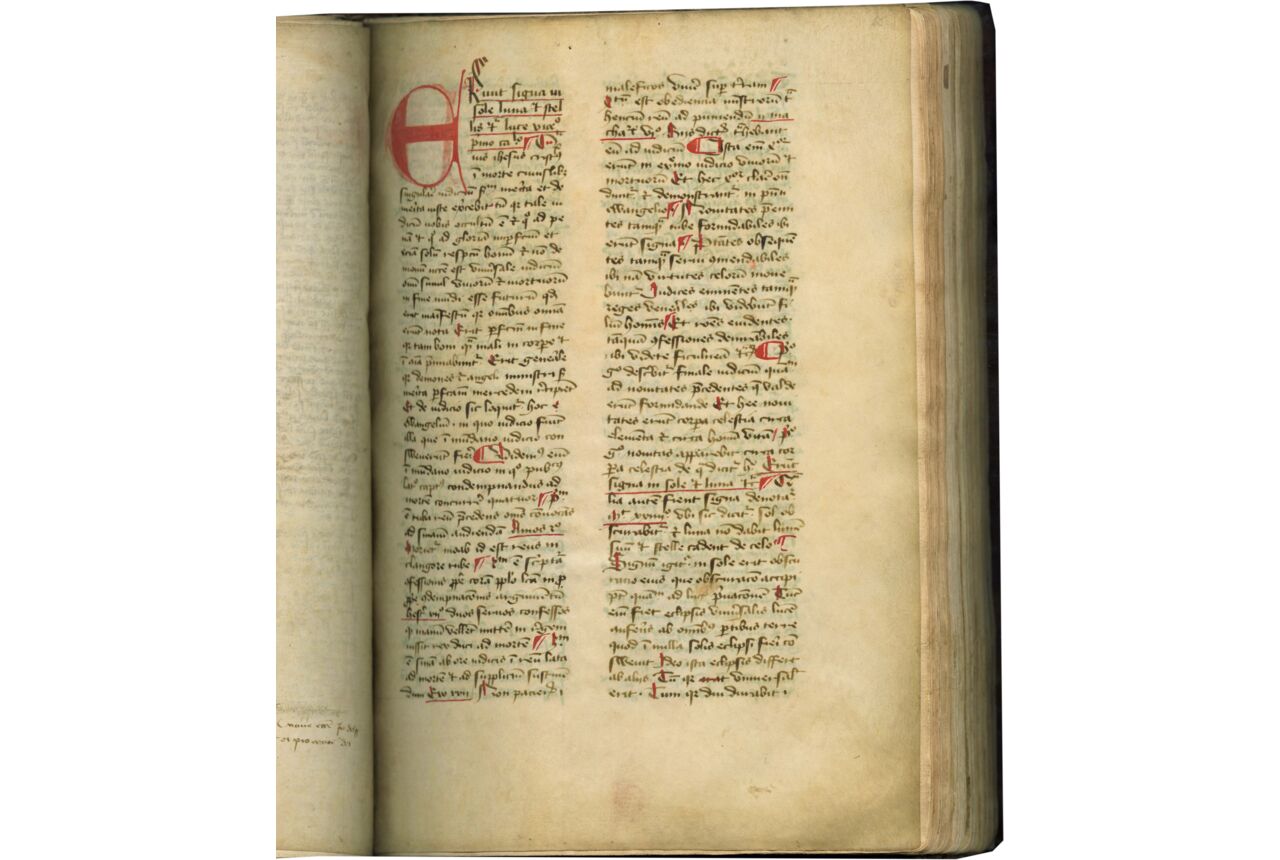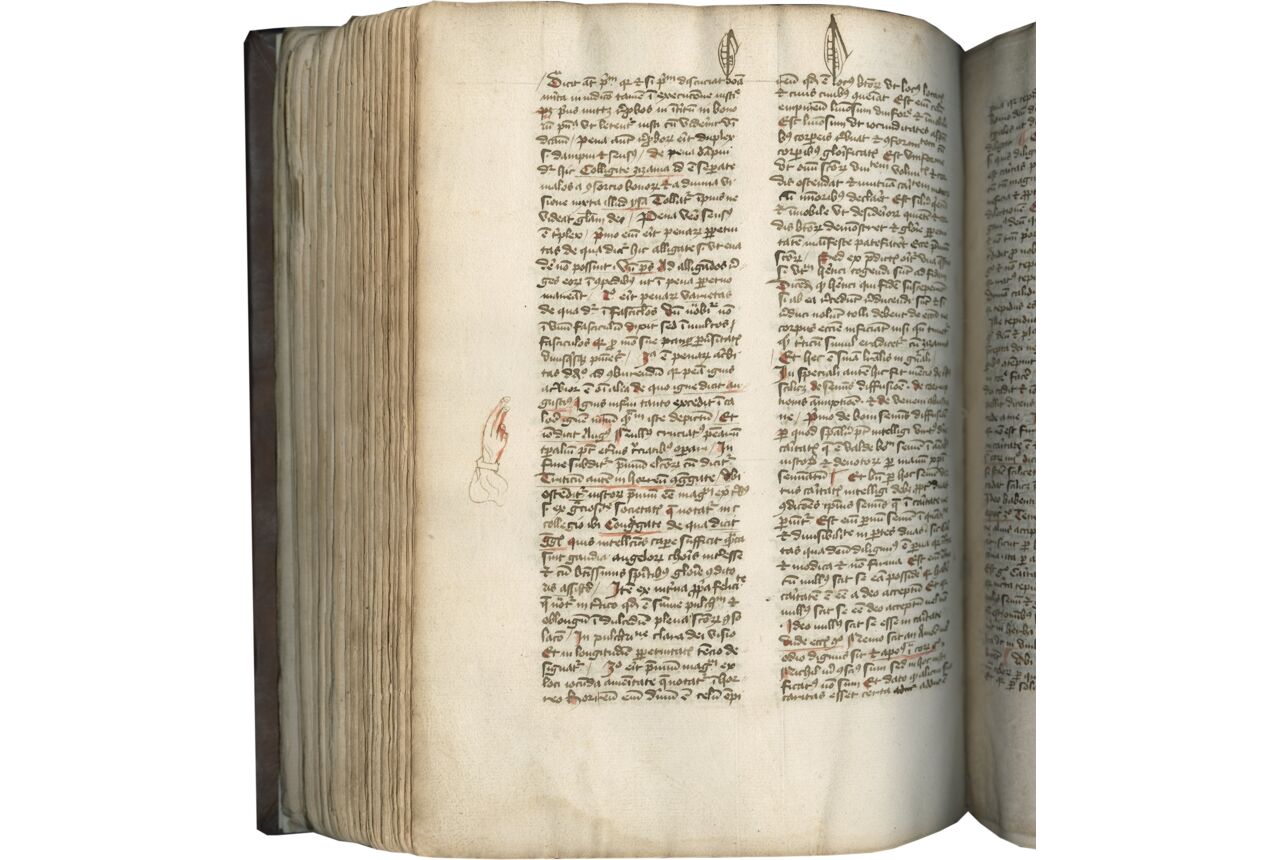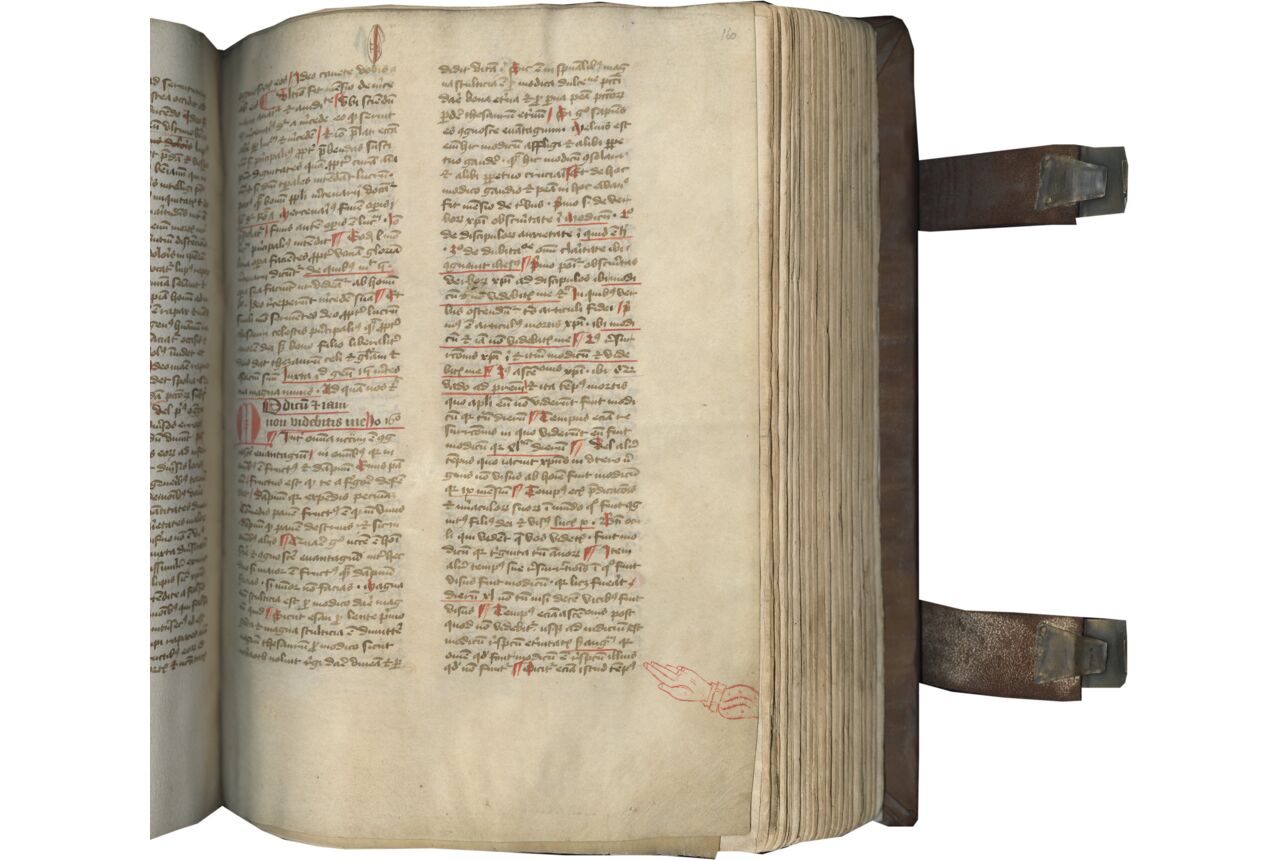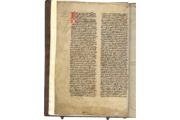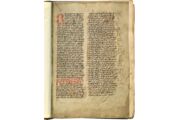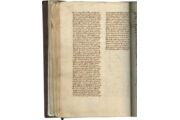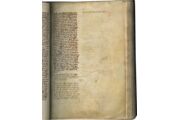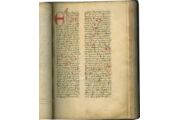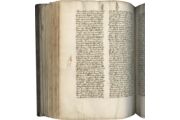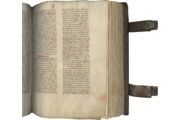ii (modern parchment) + 275 + i (modern parchment) folios on parchment and paper, outer and center bifolium of each quire are parchment, remaining leaves are paper, ff. 2-63, quite thick, chain lines are difficult to discern, watermarks, bow and arrow, perhaps similar to Briquet 789, Perpignan 1380, or 799, Paris 1406; ff. 66-138, similar to crown, Briquet 4638, Strasbourg 1438; tete de boeuf, Briquet 14177, Utrecht 1423, or 14178, Fleurus 1431, Holland 1431, La Neuville 1431, Utrecht 1432, Bruges and Namur 1433; and an unidentified watermark, ff. 1-64 with contemporary, possibly original, foliation in ink in Arabic numerals, middle upper margin, ff. 65-end, modern foliation in pencil top outer corner recto, complete (collation i-iv16 [through f. 64v] v-xxi12 xxii7 [quire of 12, lacking 8-12, cancelled blanks]), frame ruled very lightly in lead, some prickings remain top margin, layout varies ff. 1-64, (justification 212 x 155-150 mm. ), written in a small, uniform gothic cursive (with loops) in two columns of 52-47 lines; ff. 65-274, (justification 213-203 x 149-140 mm.), written in a gothic cursive script (with loops) in two columns of 39-41, decorated ascenders (some with faces, e.g., ff. 108, 119, 148, 154, 159), red paragraph marks and underlining, majuscules within the text stroked with red, 2- to 3-line red initials, 6-line red initial f. 1, some dampstaining lower margins, a few stains within the text, frayed edges at beginning, overall in very good condition. Bound in a modern blind-tooled binding over stout wooden boards, cut flush with the bookblock (in a style mimicking 15th-century bindings), sewn on new thongs, spine with five raised bands, five metal bosses (corners and middle) both covers, fore-edge knobs at the bottom edge, two straps, fastening back to front with brass catches and clasps, in excellent condition. Dimensions 290 x 210 mm.
This manuscript’s large format, sturdy binding (a modern facsimile of a fifteenth-century binding), use of both parchment and paper, textual corrections, maniculae (pointing hands), and solidly medieval contents, all add up to make this a “perfect” example for classroom use. Its combination of patristic homilies and fourteenth-century sermons together in one manuscript raises interesting questions regarding the reception and use of these texts. Lacking a critical edition, the sermons by Francesco degli Abbati are rare on the market (only two sales recorded in the Schoenberg Database).
Provenance
1. Written in the Northern Netherlands, likely in Delft, in the second quarter of the fifteenth century, as suggested by the evidence of the script and the watermarks, and early evidence of ownership in Delft (see below). There is a date, “1434” in modern pencil on f. 64, that is perhaps a tracing of a medieval date (the numerals are very similar to those used in the early foliation); if this could be verified, it would be evidence that our manuscript dates before 1434.
2. Bequeathed to the library of the church now known as the Nieuwe Kerk (the New Church) in Delft by a certain Nicholas; see f. 64v: “[first line scraped away, partially legible under ultraviolet: “Pertinet iste liber <with another word above the line> nycolao <?> <presente> <et>] post mortem suam sociis <?> nove ecclesie in Delft/ Si quis eum invenitur reddat ei pro amore dei.”
One manuscript from this library is listed in Medieval Manuscripts in Dutch Libraries (Online Resources). Another manuscript from this library sold at Sotheby’s, December 2, 1986, lot 43 (present location unknown); this manuscript, a copy of the Postilla of Nicholas of Lyra, another Franciscan, is almost identical to our manuscript in size and the construction of the quires with both paper and vellum sheets.
The New Church (formerly the Church of St.-Ursula) in the marketplace of Delft is one of the most important surviving medieval buildings in The Netherlands. It is the burial place of the Princes of Orange. Founded in 1381 under Duke Albrecht of Bavaria and Straubing-Holland as Delft’s second parish church and consecrated to St. Mary, and later, in 1404, to St. Ursula as well. The original wooden church was replaced by a church in stone, built between 1384 and 1412, when the tower was completed. In 1536 it was severely damaged in a fire, which destroyed much of Delft. Following the iconoclastic riots of 1566, the church was confiscated by the Protestants, and renamed “Nieuwe Kerk” (the New Church).
3. nContemporary corrections throughout, particularly in Gregory’s Homilies, with identifications of the Gospel lemmata at the beginning of each homily and the liturgical occasion, also added in the same hand.
4. Evidence of use include unusually large and detailed maniculae (pointing hands), most in red (for example, ff. 77, 84v, 104v, 135v, 191, 178v, 251).
5. Sold at Sotheby’s, December 1, 1998, lot 81.
6. Described on this site (Les Enluminures, TM 2); purchased by Forum Antiquarian Books in 2007.
7. Belonged to the eminent theologian and book collector, Klaus Berger (1940-2020), Professor of New Testament Theology, University of Heidelberg.
Text
ff. 1-64v, [prologue], incipit, “Reverendissimo atque sanctissimo fratri episcopo secundino Gregorius servus servorum dei ... que emendate sunt certiores fiant,” Explicit prologus; [table of contents, numbered and with folio references added in a contemporary hand], Incipit tabula Omeliarum beati gregorii pape secundum quod ab eodem edite et conscripte, incipit, “ [i]. Omelia sancti ewangelium secundum lucam. In illo tempore dixit ihesus …,” Explicit tabula omeliarum; Incipit prima, [f. 1v], incipit, “In illo tempore ... Dominus ac redemptor ... [Homily 40], In illo tempore dixit Jesus disciplulis suis …, In verbis sacri eloquii ... per se in vestris mentibus loquatur … per infinita seculorum secula, amen”: f. 63, [List of liturgical occasions and corresponding homily, with the location in this manuscript], incipit, “Dominica 2. adventus. Sunt signa in sole et luna, Omelia prima ff. prime; … De Sancto andrea, Ambulans ihesus iuxta mare galilee, Omelia 5, ff. 5 … Item de una virgine, …Omelia 12, ff. 10”; f. 63v, [Homily 37, PL 76:1274-1281], incipit, “In illo [tempore] dixit Jesus turbis …, Si consideremus … contulit ihesus christus dominus noster qui vivit, etc.”; [Followed by two short paragraphs, added in another hand, the second a passage from Gregory’s Dialogues on sin; and the date, 1434, in pencil (perhaps modern tracing of an earlier date?); f. 64v, blank, apart from ex dono note; see Provenance, above];
Gregory, Homilies on the Gospels; edited Étaix, 1999; printed in Migne, PL 76:1075-1312, and available in English translations (Bhattacharji, 2001, and Hurst, 1990; Stegmüller (Online Resources), no. 2646; Dekkers, CPL, 1961, no. 1711. All 40 are included here; homily 37 is copied twice, following homily 36 on f. 52, and on ff. 63v-64. A contemporary annotation added in the upper margin before this second copy of the homily on f. 63v explains that this homily should not be copied here but should instead be copied before f. 52 (“Hec omelia vacat hic et scribitur ante integralis fo. 52 vt patet in tabula in ultimi linea”). The homily was in fact correctly copied the first time, but it was omitted in error in the table on f. 63, and then presumably copied again since someone concluded it had also been omitted in the text.
Pope Gregory the Great (c. 540-604) delivered his homilies on the Gospels in Rome in 590-591. These sermons on the Gospel readings for Sundays and feast days were addressed to the laity, in contrast with many of his other works including the Moralia in Job which were addressed to monks, and they consequently focus on moral teaching, and are enlivened by anecdotes. They were immensely popular during the Middle Ages, surviving in more than more than 1,000 manuscripts (FAMA and Mirablile, Online Resources), and are still widely read today.
ff. 65-274, incipit, “Erunt signa in sole luna et stellis etc. luce vicesimo primo capitulo [Luke 21: 25]. Quamvis ihesus cristus in morte cuiuslibet singulare iudicium secundum merita et demerita ...”; …. [f. 272], Cum videritis abhominationem desolacionis, etc. Mt 24[:15]. Videmus quod unaqueque res habet ... plangent peccatores culpam, Et sic est finis”; [f. 274v-275v, blank].
Franciscus de Abbatibus, OFM, Postillae super evangelia dominicalia; these sermons lack a modern edition (indeed they have never appeared in print), but their manuscript tradition testifies to their influence. Schneyer II, 1970, 55-59, lists 24 manuscripts, not including this one; and other sources record additional manuscripts: Reims, BM, MS 184, Vitry-le-François, BM, MS 61, Cambridge, Fitzwilliam Museum, Add. MS 350, Naples, Naz., V.E.20, f. 94, Naples, Naz., MS VII.E.9, f. 85, Bamberg, MS Bibl. Theol. 9 (Q.II.35), St Bonaventure University, Holy Name MS 58, St. Bonaventure University, Holy Name MS 64, and a manuscript in the Collection of Otto Volbehr.
This is the complete cycle, with small differences from the 48 sermons listed by Schneyer: lacking his sermon 24, and with variations in the order, here 9, 11 (f. 122), 10 (f. 134), 12 (f. 141), and 23 (f. 182), 26 (f. 183v), 27 (f. 189), 25 (f. 191), 28 (f. 195). See also Stegmüller, no. 2295 (Online Resources) and Roest and van der Heijden (Online Resources). One modern author has suggested they should be attributed to Franciscus OFM, who was a lector at Prague c. 1375-1404 (Online Resources, Bodleian online catalogue, citing Spunar, 1985, I, no. 67).
Very little is known about Franciscus de Abbatibus (or François de Abbati; Franciscus de Asti, Francesco degli Abbati). He was an Italian Franciscan Friar from Asti from the first half of the fourteenth century; his works include biblical commentaries and sermons, including the cycle in our manuscript and sermons for Lent (van der Heijden and Roest, Online Resources; Baudrillart, et al., 1912, vol. 1, p. 29). His sermons on the Sunday Gospels are unedited and apparently unstudied. Just a glance at the extant manuscripts available online in digital facsimiles indicate how interesting this study would be; two of the fourteenth-century copies are strikingly similar in their layout and illumination (Toulouse, BM, MS 341 and Troyes, BM, MS 715, Online Resources). The use of “postillae” rather than “sermones” in the title is also noteworthy. A “postilla” commonly refers to a biblical commentary. The word is likely derived from “post illa verba” (after that word) and refers to a commentary written out as a continuous text, in contrast with glossed manuscripts, with the biblical text and commentary copied separately. Its use here (which appears to date to some of the earliest manuscripts, for example the two manuscripts now in Toulouse, just mentioned) underlines the close connection between sermons and exegesis, which is especially marked here, since these are long, fully developed sermons on the daily Mass reading. The medieval audience was sensitive to this terminology, and one manuscript, Oxford, Bodleian Library, MS Hamilton 27, copied in Germany in the fifteenth century, originally began, Incipit postilla …, but a contemporary hand changed this to Incipit sermones.
Historical studies of the Low Countries in the fifteenth century often focus on the reform movement known as the Devotio moderna. Other aspects of the religious history of this area have been less thoroughly studied (Roest, 2005, notes that the Franciscan Observant movement in the Low Countries is often overlooked). Delft was home to one of the earliest communities of the Brethren of the Common Life (1403). The Nieuwe Kerk, however, was a secular parish church. Our manuscript, combining patristic homilies and sermons by a fourteenth-century Franciscan friar, and owned early in its history by a secular church in Delft, offers a window into another understudied aspect of the religious history of the Netherlands.
Literature
Baudrillart, Alfred, Albert Vogt, Urbain Rouziès, eds. Dictionnaire d’Histoire et de Géographie Ecclésiastiques, eds. vol. 1, Paris, 1912.
Dekkers, Eligius and Gaar, E. Clavis patrum latinorum : Qua in novum Corpus christianorum edendum optimas quasque scriptorum recensiones a Tertulliano ad Bedam, Editio altera, aucta et emendata. ed., Sacris erudiri 3, Steenbrugis, 1961.
Étaix, R. ed., Gregorius Magnus, Homiliae in euangelia, CCSL 141, Turnhout, 1999.
Etaix, R. “Répertoire des manuscrits des homélies sur l'Evangile de saint Grégoire le Grand,” Sacris Erudiri 36, (1996), p. 107-145.
Bhattacharji, Santha, transl. Reading the Gospels with Gregory the Great: Homilies on the Gospels 21-26, Petersham, Mass, 2001.
Hurst, Dom David, tr. Gregory the Great: Forty Gospel Homilies, Cistercian Studies 123, Kalamazoo, 1990.
Roest, Bert. “Franciscans between Observance and Reformation: The Low Countries (ca. 1400-1600),” Franciscan Studies 63 (2005), pp. 409-442.
Schneyer, Johannes Baptist. Repertorium der lateinischen Sermones des Mittelalters, Beitrage zur Geschichte der Philosophie und Theologie des Mittelalters, 43/1-11, Münster, 1969-1990.
Spunar, Pavel. Repertorium Auctorum Bohemorum Provectum Idearum Post Universitatem Pragensem Conditam Illustrans, Wratislaviae, 1985.
Online Resources
“Medieval Manuscripts in Dutch Collections”
http://www.mmdc.nl/static/site/
Stegmüller Online (Repertorium Biblicum medii aevi)
https://www.repbib.uni-trier.de/cgi-bin/rebihome.tcl
Gregorius I, Homiliae XL in Evangelia, Mirabile,
https://www.mirabileweb.it/title/homiliae-xl-in-evangelia-title/2406
FAMA: Oeuvres latines médiévales à succes
http://fama.irht.cnrs.fr/en/oeuvre/268546
Mirabile, Archivio digitale della cultura medieval (Digital Archives for Medieval Culture)
http://www.mirabileweb.it/title/homiliae-title/11345
http://www.mirabileweb.it/title/postilla-super-evangelia-dominicalia-title/1003
Patrologia Latina
https://patristica.net/latina/
“Oude en nieuwe Kerk Delft”
Home (oudeennieuwekerkdelft.nl)
Maarten van der Heijden and Bert Roest, “Franciscan Authors, 13th-18th Century: A Catalogue In Progress”
https://applejack.science.ru.nl/franciscanauthors/
“Franciscus de Abbatibus, 14th century (?): Postilla super Euangelia dominicalia [Latin]”
https://medieval.bodleian.ox.ac.uk/catalog/work_6433
Toulouse, Bib. Mun., MS 341
http://initiale.irht.cnrs.fr/codex/4126/12363
Troyes, Bib. Mun. MS 715
http://initiale.irht.cnrs.fr/codex/4802/13190
Oxford, Bodleian, MS Hamilton 27
https://medieval.bodleian.ox.ac.uk/catalog/manuscript_5988
TM 1179


